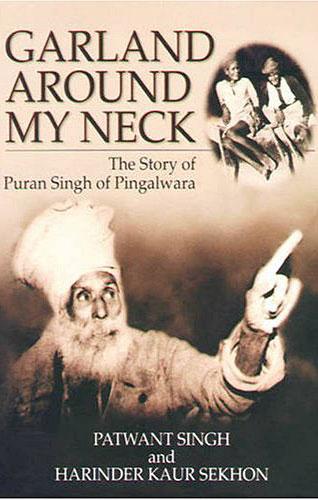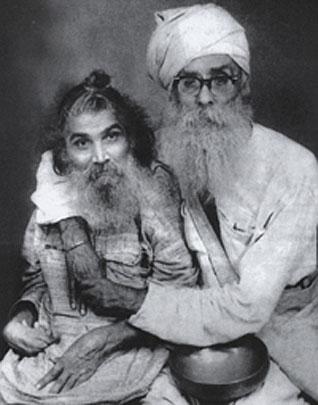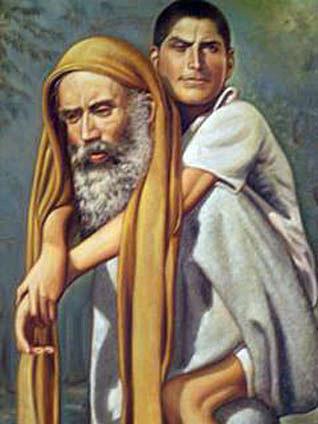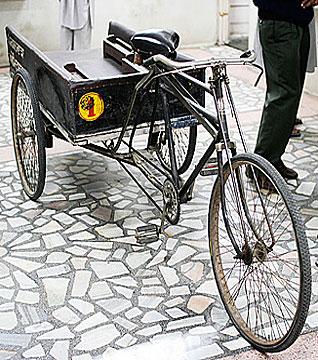
Photo below, first from bottom - the cycle-cart used by Bhagat Puran Singh during his last few years, to transport his charges.



Books
Garland Around My Neck:
The Story of Bhagat Puran Singh & Piara
A Book Review by ANGAD SINGH
Garland Around My Neck: The Story of Puran Singh of Pingalwara, by Patwant Singh and Harinder Kaur Sekhon. UBS Publishers, New Delhi, 2001. 173 pp. ISBN: 1901363406.
Garland Around My Neck: The Story of Puran Singh of Pingalwara is a biography of Puran Singh and the story of the creation of the hospice for the destitute and the needy, known as Pingalwara (literally, "The Leper Colony").
It shows how the life of Bhagat ji (as he was popularly known: Bhagat - "God's Devotee") was intertwined with the history of Pingalwara. It is a story of how a homeless person himself became a home - Nithaanvyaan de thanv or "the home of the homeless"!
This is a story that could move the most apathetic of persons, and would compel him to taste this nectar: the nectar of contentment that comes from serving the most pained, dejected and neglected of our fellow beings.
I thank the authors for having brought this story to light: Patwant Singh who has authored classics like The Sikhs and The Golden Temple, and Harinder Kaur Sekhon, a post-doctoral researcher and an academic writer on modern Punjab.
In the Introduction, the authors dedicate a few pages to the history of Spirituality and Religion in Punjab and India, from the time of Buddha to Guru Nanak and beyond, thus laying out a context to Bhagat Puran Singh's lifework. This makes a good reference point for those unfamiliar with his antecedents.
The authors attribute the 20th century (and continuing) poverty and homelessness in India mostly to the Hindu caste system which plagues the country and leaves countless people helpless on the streets. Beggars and the handicapped litter the streets. "They are helpless and helping them would do no good" was the common belief at the time.
Bhagat Puran Singh proved this belief wrong through a life of service and dedication to these people; he created help for the helpless ... a home for the homeless ... and hope for the ones who had given up on humanity.
The authors explore the life of Bhagat Puran Singh from his birth all the way to his last days. Because there were not many written accounts of people in those days, parts of the book are based on interviews with people that knew Bhagat ji personally.
Puran Singh was born to Chibu Mal, a wealthy Hindu money-lender, and Mehtab Kaur, a young widow he was betrothed to in a "chadar" ceremony.
When Mehtab Kaur was expecting, Chibu Mal wanted to abort the baby. Having already lost three children before, Mehtab Kaur pleaded with Chibu Mal to allow her to have the baby, on the express promise that this child would never claim any of Chibu Mal's property or come in his way of loving his other family.
From an early age, his Sikh mother taught Puran the Sikh ideals of humility, selflessness, and seva, as well as love for humanity, animals and the environment which influenced the rest of his life.
Mehtab Kaur would teach the child by example. She told Puran to always to pick up harmful objects off the road such as bricks and glass. She said that it takes less energy for them to remove the brick than it would for an ox that had to pull a cart with a broken wheel to go over it.
She taught him to treat all people with respect and to serve others. On her death bed, she made him promise to dedicate his entire life to service of others.
He was to keep the promise, literally.
Bhagat ji's life-journey to create Pingalwara is probably one of the most inspiring things I have ever encountered in my life.
The odds that were against him were enormous. He did his entire work, including cleaning the feces and wounds off the suffering, single-handedly for years before he received any help. Almost always, the financial resources ran tight, but he managed to pull through.
Although misunderstood as the home for cripples, the authors clarify the mission of Pingalwara: "He found it odd that while wealthy benefactors were willing to fund major hospitals, they were unmoved by spectacles of dying persons on the street."
Puran Singh first came up with the idea of caring for the destitute and disabled when he was doing seva in a gurdwara. "An old man with a badly infected leg limped into the gurdwara one day. Puran Singh, on seeing maggots oozing out of a very small hole in his calf, took him to Lahore's Mayo Hospital - the biggest in undivided (pre-Partition) Punjab. The ailing man was admitted and given a proper bed with clean sheets to sleep on. At this, he gratefully remarked, ‘I know I am going to die soon. But at least here I will die with dignity.'"
He learnt from the incident that every man and woman has the right to live and die in dignity.
Four years after his mother's death came the turning point in his life.
In 1934, he found Piara, a young boy about four years old. "A mute, mentally impaired and physically deformed, he was suffering from acute dysentery and was covered with flies and his own feces."
Puran Singh brought him to the gurdwara and cleaned him.
"From that day on they were inseparable for the next 14 years (until 1948, when he had assembled a group of those, discarded like Piara, with whom he could leave him for a few hours at a time)."
Puran Singh carried Piara on his back - literally - every day for those 14 years.
Puran Singh's inspiration to keep going was Piara - whom he considered the "garland around his neck"!
When the cataclysmic Partition of Punjab and India took place in 1947, Bhagat Puran Singh found himself on a caravan to Amritsar from Lahore. He decided to settle in Amritsar and start a home for destitutes and the disabled.
Gradually the number of his patients increased and he was always in search for a better shelter for them. Over the course of the years, Bhagat Puran Singh moved from abandoned homes to movie theatres to bus stands for a shelter.
As word spread of an "unkempt tall and thin man" who was caring for so many "cripples", he started to receive donations. Donation boxes were set up around the city and the Darbar Sahib (Golden Temple, Amritsar). Slowly, he began to get small grants from organizations like the S.G.P.C. (the Shiromani Gurdwara Prabhandhak - "management" - Committee) and from private donors as well.
Ultimately, he was given a plot of land by the Government of Punjab to build a permanent shelter for his charges.
Puran Singh did not want this building to be just another hospital. He "believed that fully-equipped hospitals already exist, but what the common man needed is not another... hospital, but greater boarding facilities, as he can always avail of the outdoor treatment provided by existing hospitals."
The inmates at Pingalwara received food, clothes and a bed to sleep in. They also were given literature that Bhagat Puran Singh had written or republished, because Pingalwara had its own printing press. The popularity and needs of Pingalwara were increasing and with the help of many contributors, it finally became a viable institution.
Many know of Bhagat Puran Singh merely as the founder of Pingalwara. However, he found the time to do much more. He cared for animals and the environment, in addition to humans in need, and always kept all the three in mind whenever he did anything.
For example, he would not take a car or a bus, but instead he would push his patients in a handcart.
"Since the only way he knew of persuading people was by personal example, he seldom travelled by car or bus, and one of the questions that he invariably asked people was - how many miles had they walked that day? He recommended eight to ten miles a day!"
This was because Bhagat Puran Singh sensed an upcoming environmental crisis as early as 1928. He printed and distributed material for environmental preservation on recycled paper and created a movement against deforestation.
Alongside environmentally-friendly Pingalwara, he also created an animal shelter for sick and stray animals.
Not only did he change the lives of thousands himself, he inspired millions to walk the path of service. His life was inspirational, every moment of it ... He chose not to marry or have a child of his own, so that he could devote all of his time to his needy and helpless charges.
Whatever he did, he did with humility and with the spirit of selflessness. At the same time, he did not shy away from documenting his work, talking about it, or asking for donations. His sole aim was to inspire more people to join the movement of compassion.
Bhagat Puran Singh was finally going to be nominated for the Nobel Peace Prize when he passed away on August 5th, 1992 at the age of 88, after suffering much neglect by the Government of India.
Not that he would have cared for its support; but I feel it is still a travesty for such a spirit and force not to be recognized by the people of this earth, let alone his own government.
This 173-page book is a great read for anyone who wants to be inspired by the force of the human spirit. The book has great historical photographs like that of the personal belongings he left (you can count them on the fingers of one hand) and the trees planted by the person that inspired him and still stand as a shrine to her - his mother.
Through very words of Bhagat Puran Singh himself, quoted generously in the book, his deep reverence and commitment to his mother's dream cannot help but make one marvel at of the power of Motherhood.
The book is divided into five chapters and is a fairly easy read with nice-size fonts. Interesting, informative and inspirational, it is a must read for every a Sikh, nay, every citizen of the world and lover of humanity.
15-year old Angad Singh is a filmmaker - of "One Light" & "Roots & Wings" fame - based in Atlanta, Georgia, U.S.A.
[In the U.S.A. and Canada, the book can be obtained from the Sacha Sauda Bookstore in Canada - http://www.sacha-sauda.ca/search.php?action=10&s=Y. Alternately, it is also available for a slightly higher price at www.amazon.com. In India, it is available at http://www.gobookshopping.com.]
January 23, 2009
Conversation about this article
1: I.J. Singh (New York, U.S.A.), January 25, 2009, 7:47 AM.
An excellent story that we all need to read and reread again and again, for we soon tend to forget the essentials in the merry and maddening pace of life.
2: Peen Kaur Dhatt (Brampton, Canada), January 25, 2009, 7:09 PM.
We seriously need to gather momentum and push for a Nobel Peace Prize nomination, and other posthumous recognition, for Bhagat Puran Singh ji.
3: I.J. Singh (New York, U.S.A.), January 25, 2009, 8:34 PM.
Bhagat Puran Singh was nominated for the Nobel, but died soon after and before any decision was reached. I don't believe there is any tradition of a posthumous Nobel Award; other ways or recognizing do exist.
4: Claudia Gaspar (Sao Paulo, Brazil), January 26, 2009, 6:50 PM.
Bhagat Puran Singh probably will not receive a more than deserved Nobel Prize but a foundation with his name to accomplish his ideals is possible and desirable. I want to ask my friend Gurmeet Kaur who sent me this article to think seriously in becoming one of 'Bhagat Puran Singh Seva Foundation' promoters. Saints aren't those who purportedly make miracles after their death but those whose lives are miracles of selfless service.
5: Kulbir Singh Malhotra (Sydney, Australia), January 26, 2009, 11:05 PM.
Bhagat Puran Singh ji was a great soul. We need to push for change in the tradition re awarding posthumous Nobels to such great souls.
6: Brijinder Khurana (Delhi, India), January 27, 2009, 2:48 AM.
I totally agree with I.J. Singh ji that "It's an excellent story that we all need to read and reread again and again, for we soon tend to forget the essentials in the merry and maddening pace of life." Since the time of my birth, we have been listening to the stories of Bhagat Puran Singh ji. My great-grandfather and grandfather, both were doctors and had migrated from Pakistan at the time of partition. My father was around six years old. Since then, through all their days of hardship, they donated at Pingalwara (whatsoever was possible). The tradition is being followed by me, and my family to date. When we were kids, we used to go alongwith our parents to Pingalwara, Amritsar, during our trip to our grand-parents and now I go with my husband and with my kids to Pingalwara with whatever little support we can offer to them. I take my children with me so that they can also feel the pain and relief of patients. My kids used to bring the books being published by Pingalwara, which were useful for them in doing their home-work and above all to make them good human beings. I feel myself blessed that I have been a part of the help to the needy with the grace of God. The whole atmosphere at Pingalwara is pure, the staff right from the entrance gate upto the other volunteers are blessed by the Almighty that they serve with smiles on the faces, truly in the spirit of Bhagat Puran Singh ji.
7: Kuldip Singh (U.S.A.), January 27, 2009, 10:16 AM.
Very inspiring story. Angad Singh has done a wonderful job in presenting the review.
8: Dupinder Kaur Sidhu (New Jersey, U.S.A.), January 28, 2009, 11:18 AM.
Excellent book review. I totally agree with the previous comments that we all need to read this book and have it in our homes. Bhagat Puran Singh ji is the supreme example of living a selfless life in the whole world. As I was growing up in Ludhiana, I remember the Pingalwara cart collecting donations coming to our colony often. Our mother would always ask up to go out and put "attaa" - flour - in the drum on the cart. The man riding the cart would give us lots of papers to read. This was the material for environmental preservation - printed on recycled paper. Bhagat ji recycled paper by using the blank side of already printed papers. Some of them were even DOUBLE recycled if it had small header printed or very light printing. Pingalwara printing would be in big bold letters on already printed papers. I have been in the U.S. for the last 15 years and in the last decade we started hearing about global warming campaigns to involve everyone in America. The first thing that came to my mind was the printed material from the Pingalwara cart guy that I received years ago. I was thinking that Bhagat ji has been trying to tell us all this for a long time. He also put it into practice by recycling waste paper to send his message to public. Bhagat ji's vision is still alive in the great organization, Pingalwara. Supporting that organization will be honouring Bhagat ji. We should all make an effort to support Pingalwara with volunteer time and donations. Most humbly, I would like to point out that Pingalwara literally means 'The Cripple Colony' and not 'The Leper Colony'. Again, thanks for the book review and spreading awareness about this great soul.
9: Jora Singh Brar (Guelph, Ontario, Canada), January 29, 2009, 5:12 PM.
Dear Angad, your book review is very very nice. I like it. Thanks a lot for presenting a factual image of Bhagat ji, a great saint of the 20th century. I am also pleased to enclose my heart-felt congratulations to the authors of this publication, which will act as a source of inspiration for generations to come.
10: Mlle. S. (Georgia, U.S.A.), January 31, 2009, 12:13 PM.
Angad: Great review! I'd love to read the book - perhaps you can lend me a copy. I'm so glad you're in my French class this year - I love learning new things, and I've read so much about the Sikhs this year. We share so many beliefs in common. Great job, being a "cultural ambassador!
11: Sukhmandir Kaur (California, U.S.A.), May 02, 2009, 2:32 PM.
Bhagat Puran singh is an example to all people and especially Sikhs, of caring for humanity, other species, and our environment, all of which are connected to the health of the planet and it's various lifeforms.
12: Ajit Kaur (Delhi, India), November 03, 2009, 10:32 AM.
Just to add ... Bhagat ji also has some writings to his credit. He was a great propounder of tree plantation because he long ago could foresee what the human race was doing by cutting down trees and what we would land up in. His writings are available free of cost at various places in Amritsar. Many have read about him ... reading what he wrote would make interesting reads too.
13: Manpreet Singh (India), February 04, 2015, 6:34 AM.
I am really inspired by Bhagat Puran Singh ji ... I consider him the embodiment of God on earth and want to follow him but in reality, who can emulate him? Great man. Great life.


